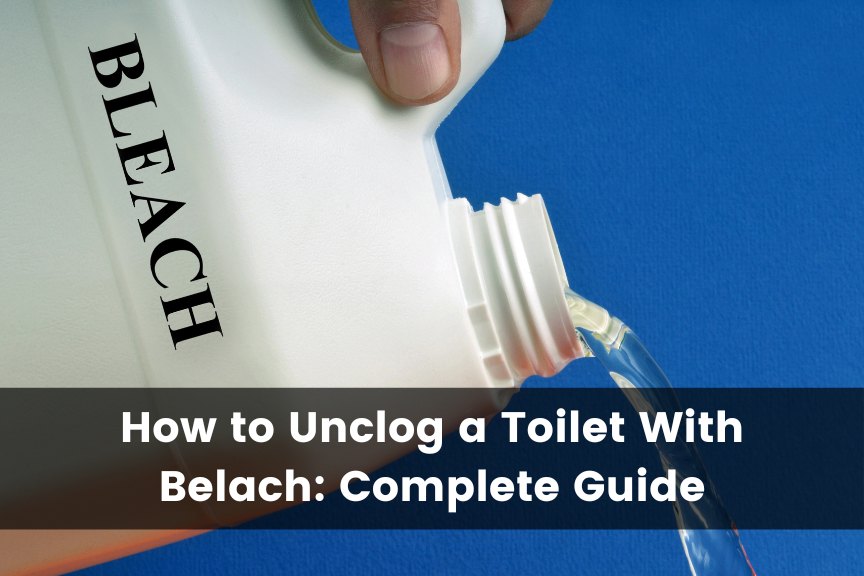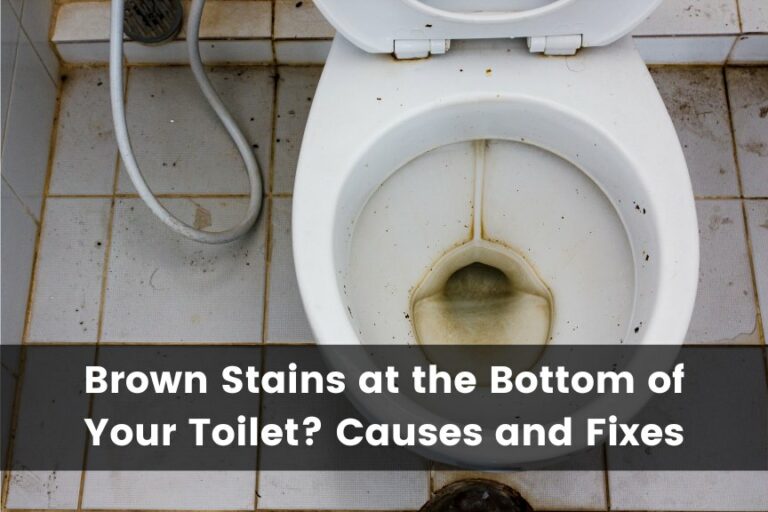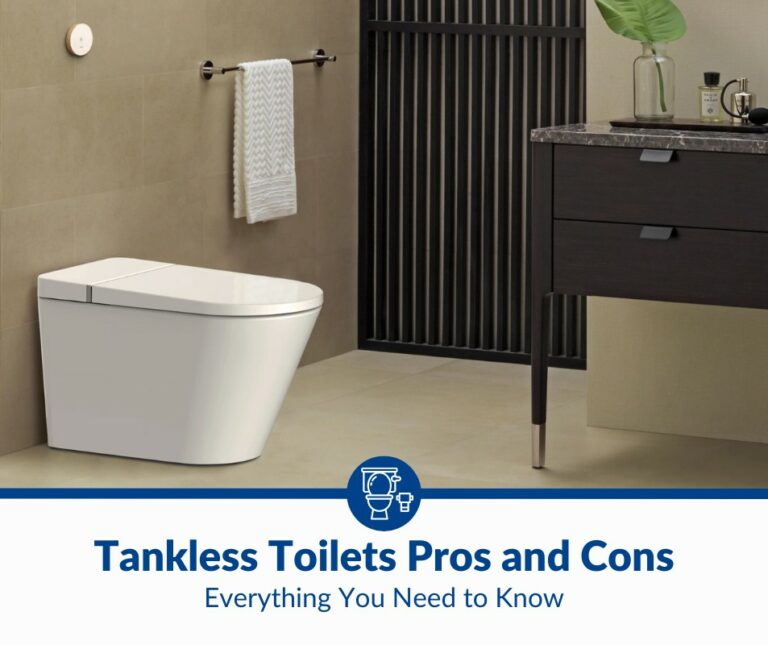How To Unclog a Toilet With Bleach: The Complete Guide
A clogged toilet bowl can be unhygienic, but it can also be problematic, especially if the situation worsens and you keep flushing, eventually turning your bathroom into a pond. You probably want to avoid booking an expensive plumber, so can bleach unclog a toilet?
Add 1 to 4 cups (240-960 ml) of bleach to the toilet bowl to unclog the toilet with bleach. The higher the volume of water in the bowl, the more bleach you’ll need to use. Let it sit for 10-15 minutes, and flush the toilet. Keep in mind the bleach method works only for minor clogs.
In this article, I’ll explain why bleach isn’t always the best option to unclog a toilet. I’ll also offer some other solutions for your stuffed-up problems, which might spare you from seeing your trusted plumber too often.
Can Bleach Unclog a Toilet?
Bleach can unclog minor clogs in your toilet. Its chemical composition makes organic dirt water soluble, so it can help with unclogging. However, it isn’t sufficient to unclog very severe blockages.
Bleach’s primary function is to disinfect, neutralize viruses and bacteria, and remove stains, so it might be better to use it as a cleaner after the fact.
How to Unclog a Toilet With Bleach
If you have some minor clogs, the bleach method should work just fine. Always ensure you wear protective gloves when dealing with bleach and wash your hands immediately afterward.
1. Unclog with Pure Bleach
If the blockage is very minor, you can use bleach on its own to help unblock it. Follow the instructions below:
- Pour 1 to 4 cups (240-960 ml) of bleach into the toilet bowl.
- Let the bleach work for 10 to 15 minutes and dissolve the obstruction. Flush the toilet.
- Ensure the obstruction has passed so you don’t overfill your toilet bowl.
2. Unclog with Bleach and Hot Water
If the bleach on its own isn’t enough, you can add hot water to it to make the solution more effective. Follow the instructions below:
- Warm up some water, but don’t bring it to a boil because boiling water can crack and damage the porcelain.
- Pour 1 to 4 cups (240-960 ml) of bleach into the toilet bowl.
- After leaving the bleach in the bowl for 10 to 15 minutes, pour the water from waist height.
- After a few minutes, flush the toilet — all of the blockages should be removed.
3. Use Preventative Measures to Avoid Blockages
To avoid blockages in the future, you can use bleach to clean your toilet regularly. This helps to keep the pipes clear and ensures the system runs smoothly.
You also need to ensure you’re working with bleach safely since it’s a very harsh chemical and can cause damage if you’re not careful. Cautionary methods include:
- Wearing glasses to protect your eyes.
- Wearing rubber gloves to protect your skin. Immediately after working with bleach, wash your hands.
- Wearing a mask to protect your lungs.
You should also make sure the windows are open. If you don’t have windows in your bathroom, turn the ventilator on and open the door. Bleach fumes are basically chlorine gas that can cause fluid build-up in your lungs and even death, so a well-ventilated room is a must. Breathing in 430 parts per milligram of chlorine leads to death in only 30 minutes.
Why Isn’t Bleach Recommended to Unclog a Toilet?
While bleach is good in a pinch, keep in mind it is a harsh chemical that can damage your porcelain toilet bowl and the pipes if used excessively. While this may not seem like a problem in the short term, the cracks in the porcelain might start to trap paper, causing even bigger clogs.
If you do decide to use it, avoid pouring it into an empty toilet bowl. To prevent the cracks from forming, always use it cut with water.
Is Bleach Safe to Use?
Bleach is safe to use if you use the safety measures mentioned above — good ventilation and protection for your eyes and skin are critical. You should also be very careful not to mix bleach with anything other than water. Avoid mixing it with acids such as vinegar, hydrogen peroxide, or any type of alcohol.
While the mixture of bleach and acid creates chlorine gas, bleach and hydrogen peroxide creates a violent chemical reaction that produces heat and bubbles. Also, bleach mixed with alcohol creates chloroform. You can see why caution is needed!
Can I Leave Bleach In the Toilet Overnight?
You can leave bleach in your toilet overnight, but be careful to use it diluted. Also, make sure nobody uses the toilet while the bleach is in it since the combination of bleach and ammonia from the urine creates mustard gas.
Exposure to mustard gas leads to digestive and respiratory problems but can also cause eye and skin burns and leave you permanently blind.
Can You Mix Bleach and Baking Soda to Unclog a Toilet?
The mixture of bleach and baking soda is not effective for unclogging your toilet. You can mix bleach and baking soda together since the combination doesn’t produce any dangerous side effects, but this mixture is better for cleaning and getting rid of stubborn stains.
Other Ways to Unclog Your Toilet if You Don’t Have Any Bleach
If you don’t have any bleach on hand or you’ve tried it without success, there are other options available to you. Here’s a list of ways to unclog your toilet without bleach:
Use a Plunger
To unclog the toilet using a plunger, follow the instructions below:
- Ensure there is enough water in the bowl to cover most of the cup.
- Then, angle the cup so that it fills up with water.
- Fit the cup of the plunger over the drain, and place the extension inside the hole; this will form a seal around the hole.
- Push and pull the plunger with some force making sure it doesn’t disengage from the hole. Repeat the motion 5 or 6 times and then remove the plunger until the water in the toilet bowl is gone.
- Then, flush the toilet. If the blockage isn’t gone, repeat this until it is.
If you are looking for a good toilet plunger, I recommend this MR.SIGA Toilet Plunger and Bowl Brush Combo from Amazon.com. It has a stylish holder with two compartments for your plunger and your toilet brush.
Use a Wire hanger
Follow the instructions below to use a wire hanger to unclog your toilet:
- Sacrifice a wire clothes hanger and straighten it completely. Leave the hanging part bent.
- When your hanger is straight, secure the bent part with a piece of cloth. This is to ensure you don’t damage the toilet bowl.
- Secure the fabric with duct tape to stop it from falling off. Push the bent end into the drain and start pushing until you find the blockage.
- Thrust and turn the hanger to dislodge the blockage. Push until you feel no more resistance and see the water drain out of the toilet bowl.
- Flush the toilet to make sure the problem is resolved. If you don’t succeed on the first try, repeat until you remove the blockage.
Use a Plastic Bottle
Follow the steps below to use a plastic bottle to unblock a toilet:
- Warm up some water, but don’t let it boil.
- Take a 2-liter (33 fl oz) soda bottle and fill it with hot water.
- Close the top of the bottle with your finger.
- Push the bottle with the tip down into the opening of the drain.
- Make sure it fits snugly against the walls.
- When the bottle is correctly positioned, push it with both hands. The hot water from the bottle, combined with the water pressure, should dislodge the blockage.
There’s a second method you can use that entails cutting the bottom of a soda bottle and pushing it into the toilet bowl. Here is a great video from YouTube that shows you how to do it:
Saran Wrap
Saran wrap is one of the most satisfying methods of unclogging a toilet. Simply follow the instructions below:
- Lift up the toilet seat and wrap the top of the toilet bowl in 3 or 4 layers of saran wrap.
- Flush the toilet after making sure the layers are airtight. The consequential pressure will lift up the water level and the saran wrap.
- When the saran wrap bubbles up, press firmly on it and start pumping. The air pressure will push the water and the blockage out of the toilet and into the sewage pipes.
Here is a fantastic video by As Seen on Social Media from YouTube that demonstrates the method and the effect:
Using Hot Water and Dish Soap
- Remove the toilet tank lid and close the flapper. This will stop the water level from rising. Boil some water or use the hottest water from the bathroom sink. Use a pot or empty the trash can and use it if you have to keep this hush-hush.
- Pour some dish soap, shampoo, or laundry detergent into the toilet bowl. This will make the trapway more slippery and the blockage easier to pass. It will also dissolve the fats in the blockage.
- Pour the hot water in and leave the mixture for 15 to 20 minutes. Then, flush the water and repeat if necessary.
This method is ideal if you find yourself as a guest at someone’s house and happen to clog the toilet bowl. Of course, it works great in any situation, but it’s especially good in this one because you have everything you need to solve the problem at your fingertips.
Here is a YouTube video that explains why this method works well and shows a step-by-step procedure:
Use Baking Soda and Vinegar
- Make a paste of equal parts water and baking soda. Pour the mixture into the bowl, ensuring it coats the drain well. Warm up the vinegar and pour it into the bowl. The reaction between the baking soda and vinegar will create a fizzing effect that will break up the clog.
- Leave the mixture to sit overnight to allow it to do its job better. Pour a bucket of hot water into the bowl to get rid of any remaining soda, vinegar, or parts of the backup. If the clog is minor, use all of the baking soda and all of the vinegar in one try.
If the clog is more problematic, do this in increments — this will allow for more of that fizz action and help break up and dislodge the stoppage. Flush the toilet.
Here is a YouTube video with detailed instructions:
Use a Drain Snake
If you have tried every method in the article and the blockage is still there, before you give up and decide to leave the problem in the capable hands of a plumber, try the drain snake. The drain snake is an elongated, flexible metal cable with a spring on top and a handle on the other end.
Plumbers use it to dislodge obstacles in your toilets and drains, so why should you pay for an overpriced visit when you can just buy the tool yourself?
- Cover the floor with a few plastic sheets to avoid backsplash and keep the bathroom hygienic, and wear gloves. Place the cable into the drain and snake it into the bowl. If you have placed it correctly, you shouldn’t be able to see the metal cable anymore.
- Push the handle clockwise to unfurl the cable further into the drain. When you feel the cable has met some resistance, it means it has reached the clog. To break down the blockage, turn the handle slightly in both directions to break the blockage down and pull the pieces apart to make it easier to flush.
- Bring the cable back and ensure all the debris has been washed away. Flush a few times if needed. Clean the drain snake well.
Try this POPULO Electric Drain Auger, which you can find on Amazon.com. This powerful electric drain auger has a long-lasting rechargeable battery and a 25 feet (7.6 m) cable capable of cleaning drains from 0.75 to 2 inches (1.9 to 5 cm) wide. It has a cable lock mechanism that keeps the machine in place while unclogging your toilet, sink, or bathtub.
Here is another nifty gadget as a last resort before calling the plumber. This Berteen Drain Clog Remover will unblock your toilet without you getting your hands dirty. This drain blaster uses high-pressure compressed air to clean out your drain in seconds — just pump the gun and press the trigger, releasing a tornado in your toilet.
It has four types of suckers and is great for unblocking any of your drains, saving you money in the long run.
Call the Plumber
If everything else fails, don’t feel bad and call the plumber. While cleaning out most of the clogs is something almost anyone can accomplish, there are just those heavy-duty clogs that put up too good of a fight. Instead of forcing a result, sometimes calling an expert is the smart choice.
A good plumber will take care of that stubborn stoppage without damaging your toilet or the pipes and just might save you hundreds of dollars in the long run.
Why Do Toilets Get Backed Up So Often?
Toilets get backed up so often because people tend to flush things that are not meant to be disposed of that way. Flushing feminine hygiene products and paper towels can clog the drain, but so can the build-up of calcium that develops over time.
Even heavier toilet paper can be the cause of the obstruction. Since American toilets have quite a small trapway of only 2 inches (5.08 cm) in diameter and narrow pipes of 3 inches (7.62 cm) in diameter, clogs are, unfortunately, just a part of everyday life.
To avoid clogging them, dispose of feminine hygiene products, wet wipes, and paper towels correctly — a simple trash can in your bathroom can take care of those, making the clogs a thing of the past.
Additionally, make sure you don’t use too much paper — did you know that Americans are the number one toilet paper consumers in the world?
Conclusion
Cleaning with bleach is an excellent way to unclog a toilet. However, it will work only on minor blockages and will damage and corrode your pipes if you use it too often.
Nevertheless, with the plumbers charging sky-high rates, sometimes DIY options are the simplest ones to use, and this article offers an abundance of ideas. Since an ounce of prevention is worth a pound of cure, the most crucial factor in clogging is — you. So think before you flush, and don’t be afraid to ask for help if you see you’re in over your head!







